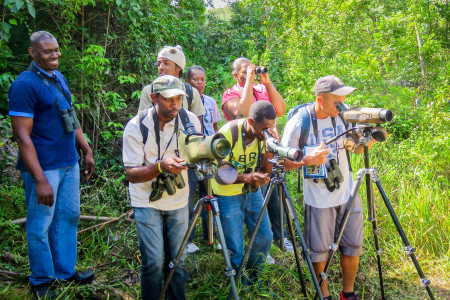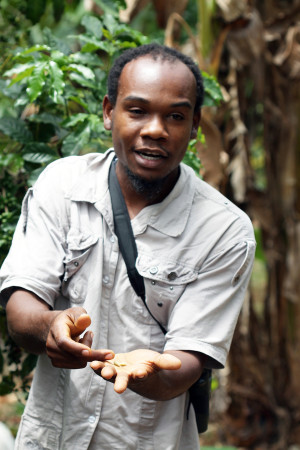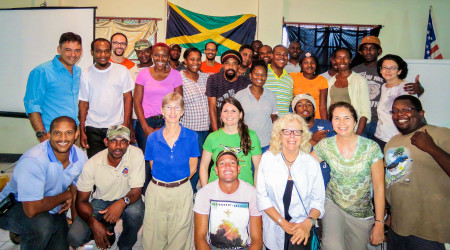
Robin Redbreast. Big Tom-Fool. Mountain Witch. Until recently, those were the only names Caribbean Birding Trail Guide Training participants would have used for some of Jamaica’s common birds. Now, after having successfully completed the five-day training course, participants know that these birds also have common English names that are recognized internationally by the birding community: Jamaican Tody (Robin Redbreast), Rufous-tailed Flycatcher (Big Tom-Fool) and Crested Quail Dove (Mountain Witch). With this knowledge, the guides can now share stories about Jamaica’s unique birdlife, including how these birds got their local names, for a growing global audience.
The Caribbean Birding Trail (CBT) Interpretive Guide Training Program was held from 15-19 June in Albert Town, in the parish of Trelawny and the heart of Cockpit Country. Hosted locally by the Southern Trelawny Environmental Agency (STEA), the course was attended by 24 participants—staff from local tour operators, non-profit organizations and independent guides. Jamaica is the second country to receive this training from the CBT, a newly launched project of the regional non-profit organization BirdsCaribbean.
The Caribbean Birding Trail facilitates exploration beyond the beach. It is birds, nature, culture and authentic experiences. Integral to delivering this is well-trained guides that are knowledgeable about the cultural and natural resources of their island, including birds. Just as important is having guides that can effectively communicate this information to audiences, in a meaningful and enjoyable way. To that end, the training covered not only bird identification but also the core principles of environmental interpretation, utilizing the curriculum developed by the National Association of Interpretation (NAI), based in the U.S.

Cockpit Country is currently the focus of CBT development in Jamaica as it is recognized globally as a Key Biodiversity Area; the region’s 74,000+ acres of forested land is home to 28 endemic birds plus over one hundred species of endemic snails, plants and more. Despite being a birding and biodiversity hotspot, Cockpit Country is not well known among travelers, or Jamaicans. As a consequence the area is frequently threatened by agricultural development and bauxite mining. By focusing on the development of sustainable tourism in this area we hope to show that there is great direct and indirect economic potential from the conservation of this special place.
Sustainable tourism that focuses on birds, nature and heritage and benefits local economies is growing in popularity internationally, and increasingly individuals are travelling to other countries specifically to see birds and wildlife that they cannot see in their own country. These same individuals have an interest in traveling in a way that does not negatively impact the environment or local people.
Facilitating the training were interpretation and bird guiding professionals from Panama, Rick Morales and Beny Wilson. Assisting Rick and Beny was Lisa Sorenson, Executive Director of BirdsCaribbean, Holly Robertson, Project Manager of the CBT, and Llewelyn Meggs, the Managing Director of Yardie Environmental Conservationists.
The training provided time in the field, utilizing the distinct limestone ecosystem of the Cockpit Country to demonstrate the relationship between birds and habitat. Burnt Hill Road is a premier birding destination in Cockpit Country; it was an ideal location to identify and learn about the forest birds of Jamaica, including 28 endemic species that can be found here.
The group also visited the Black River Upper Morass, another birding hotspot on the island located approximately 1.5 hours from Albert Town. The morass is an extensive wetland complex that offers excellent opportunities to see birds that are uniquely adapted to survive here. Some of these birds are resident species that can be found here year-round, while others are migratory and utilize the ponds and marsh areas as a winter home or to rest and feed before continuing on to points further south or north. Some of the species observed by the group at the wetlands included Northern Jacanas, Least Bitterns, Limpkins, and West Indian Whistling-Ducks, a threatened regional endemic.
The training also included guest lecturers such as Dr. Ann Sutton, the author of the Photographic Guide to the Birds of Jamaica, who gave a presentation about the importance of birds in the ecosystem and the wide variety of habitats that Jamaica offers. Dr. Sutton also generously donated copies of her book to all the participants. Mr. Michael Schwartz of Windsor Research Station also visited the training to discuss some of the conservation challenges facing the Cockpit Country region. Finally, the participants got to hear Ricardo Miller speak about how he launched his own bird tourism company in Jamaica, Arrowhead Birding. The group took full advantage of being able to ask him questions that ranged from licensing and insurance to branding and marketing.
The week culminated in a day of presentations, with the participants making use of their new knowledge to give a 5-minute talk tailored for a specific audience. The most outstanding presentations were ones that had a cohesive and clear message that was evident throughout the presentation. The best presentations also had elements of humor and whimsy, that captivated the group’s attention from start to finish and had everyone wanting to know more. Many participants were able to do this, and it was an extremely entertaining day!

The feedback on the training has been very positive from participants. One participant, Wendy Lee of Runaway Bay, reinforced that mass tourism in Jamaica is resulting in negative impacts to the environment and its people, adding that, “There’s so much more we could offer in nature tourism and endemic birds. Until we actually have proper bird tourism functioning and making a mark, it’s not going to be taken seriously. So I really have to thank BirdsCaribbean for bringing this regional experience and approach and showing us that we can do it here in Jamaica.”
Participants are already putting into practice what they learned during the training. Guides from Jakes Hotel in Treasure Beach recently took one of the hotel’s guests out to see the area’s bird life. Taking out novice birdwatchers is one way that new bird guides can gain practice guiding in a low-pressure environment before graduating to bird tours with experienced international birders.
“Ultimately, it is going to take practice and commitment on the part of the guides to keep honing their skills in bird identification, bird guiding and being an effective interpreter,” said CBT Project Manager, Holly Robertson. “With the training and the materials provided in the five days of the workshop, we are confident that the participants have what they need to get started and to begin incorporating birds into the tours that they give on the island. We look forward to continuing to work with them.”
“We are developing a post-training program to assist participants in reaching the level of skill needed to become a fully certified CBT Interpretive Guide,” added BirdsCaribbean Executive Director, Lisa Sorenson. “The program encourages logging hours in the field practicing bird identification and guiding, entering checklists into the online program eBird Caribbean, participating in an online forum where they can ask the facilitators and professional bird guides questions, and accompanying experienced bird guides on tours to learn firsthand how the bird tourism industry works.”
Once the guides become fully certified they will be promoted on the Caribbean Birding Trail website.
The training was made possible by major funding support from the U.S. Fish and Wildlife Service, the Neotropical Migratory Bird Conservation Act program and from local sponsors and partners, including the Southern Trelawny Environmental Agency, Cockpit Country Adventure Tours, Idea Wild, and Paradise Birding.
The CBT Interpretive Guide Training Program will be made available in additional countries as the project continues to develop. The CBT and other important bird conservation issues will be the topic of conversation at the 20th International Meeting of BirdsCaribbean from 25-29 July at the Knutsford Court in Kingston, Jamaica. The purpose of the meeting is to bring together Caribbean and international wildlife professionals, ornithologists, educators, students and others to share their knowledge, passion, and experiences, and participate in practical activities that promote applied conservation. Visit the conference website for more information: 2015meeting.BirdsCaribbean.org.
Companies and organizations participating in this training included: Jamaica Conservation and Development Trust, Jakes Hotel, This is Jamaica, Cockpit Country Adventure Tours, Southern Trelawny Environmental Agency, Caribbean Coastal Area Management Foundation, Dolphin Head Local Forest Management Committee, the Seven Oaks Sanctuary for Wildlife, Flamingo Beach Citizens Association, Caribbean Youth Environment Network and JUTA Tours.
